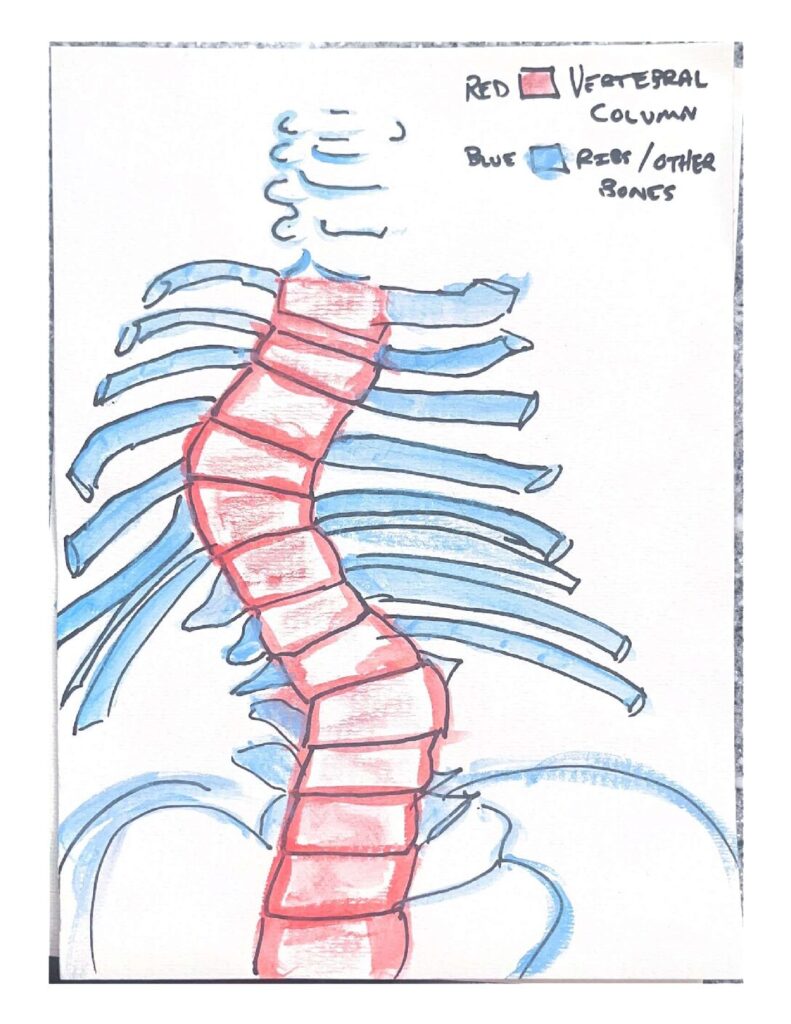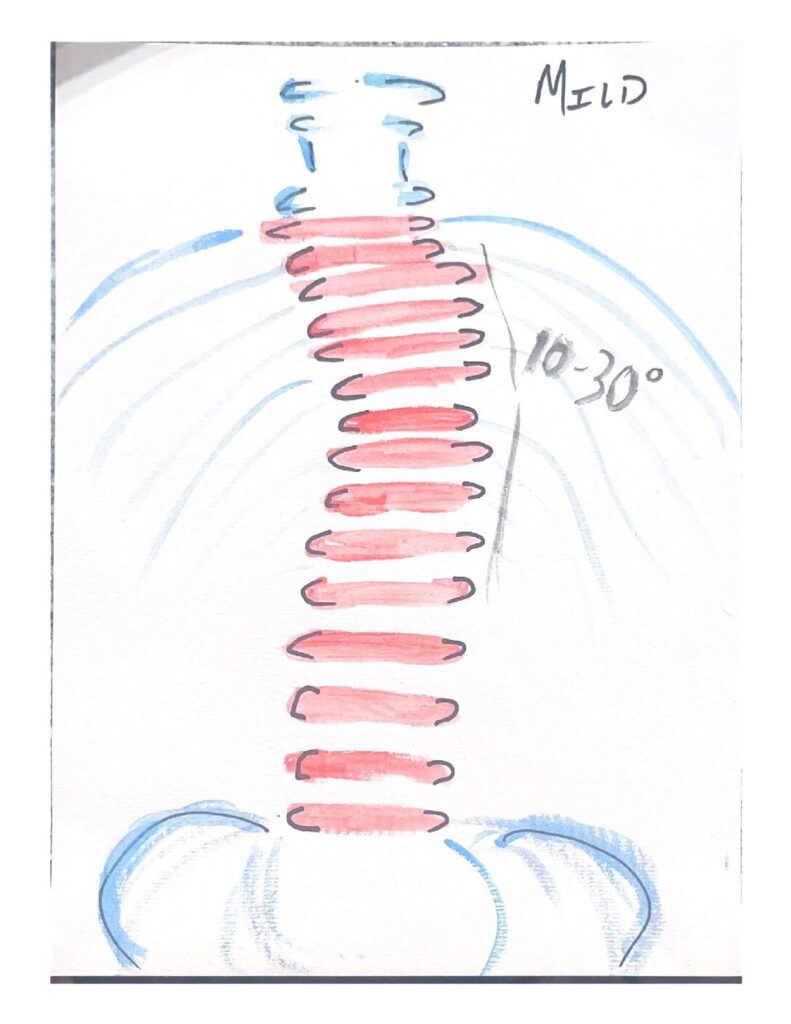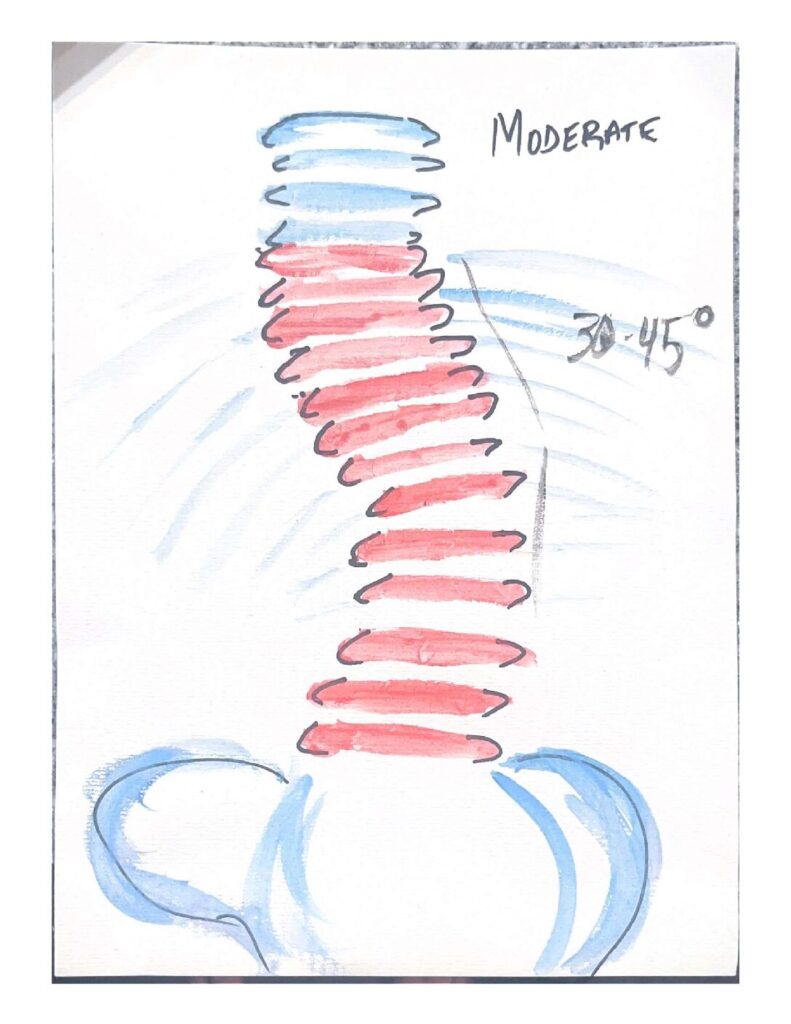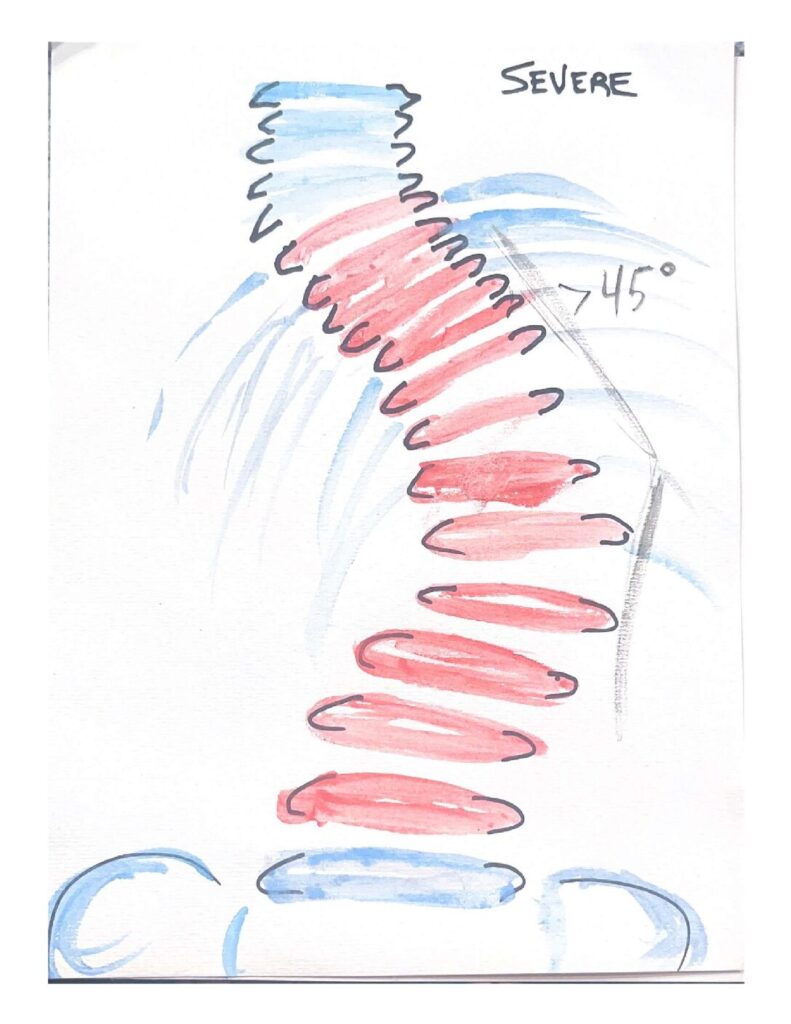I chose to do my steam project on Idiopathic Scoliosis, and I am tying it into the course objective of knowing the stages of bone development and repair. My first image is my depiction of an artist’s impression of scoliosis. The second image depicts Mild scoliosis of 10-30 degrees. The third image depicts Moderate scoliosis of 30-45 degrees. The fourth image depicts severe scoliosis at 45 or greater degrees.
Idiopathic Scoliosis is an abnormal sideways curvature of the spine of at least a 10-degree angle, known as the Cobb Angle. Most cases of idiopathic scoliosis are diagnosed during the adolescent growth spurt, which is when scoliosis curves are at the greatest risk of developing rapidly. If not identified rapidly and without monitoring, scoliosis can become significant during the adolescent years. Idiopathic scoliosis typically does not cause pain in young people, but pain may develop in later stages of life. A right thoracic curve is the most common type of scoliosis. A right thoracic and lumbar curve makes a double major curve that looks like an S curve.
In Scoliosis, curves less than 30 degrees before skeletal maturity are generally unlikely to continue to increase in curvature or cause later problems in life. Scoliosis with curvature of greater than 50 degrees will require surgical intervention in most cases. Scoliosis can also cause a rotation of the vertebrae which may cause rib humps in the back or other problems.
Experts use the Cobb Angle as a method to measure bending disorders of the vertebral column like Scoliosis. Severity is defined by the increased degree of the vertebral curve. Anything less than 10 degrees is generally considered not scoliosis or of significance and may be monitored. Mild scoliosis occurs from 10-30 degrees. At this point, bracing or other less invasive measures would be used to control the progression if the patient were in adolescence. It is less likely that this degree of scoliosis will have severe permanent effects on patients. 30-45 degrees of scoliosis is considered moderate, but in adolescence, it is immediately treated with bracing. Anything reaching the 45–50-degree threshold often falls into the realm of surgery. “Curves larger than 50 degrees are associated with a high risk of continued worsening throughout adulthood and thus usually indicate the need for surgery.” (Effects of bracing in adolescents with idiopathic scoliosis. The New England Journal of medicine, 370(7), 681.)
Bracing is the most effective form of non-invasive treatment and should prevent the progression of the curve. Once an early onset of idiopathic scoliosis is identified, “brace wear for an average of at least 12.9 hours per day was associated with success rates of 90 to 93%” (Effects of bracing in adolescents with idiopathic scoliosis. The New England Journal of medicine, 370(7), 681.) The severity of the initial curve magnitude and total months of bracing were the 2 most important variables when assessing the probability of future surgery. Surgeons can use this model to counsel families on the potential benefits of bracing and risk factors for curve progression.
Surgery is typically recommended after observation and bracing for curves that are likely to progress. Surgical outcomes do not completely straighten the spine but reduce significant curvature. (Providence Bracing: Predicting the Progression to Surgery in Patients With Braced Idiopathic Scoliosis). Increased recognition, monitoring, and bracing can hopefully reduce the need for surgery in future patients. Ongoing studies are being conducted to better understand the effects of bracing of adolescent patients with idiopathic scoliosis.
Dolan, L. A., Wright, J. G., & Weinstein, S. L. (2014). Effects of bracing in adolescents with idiopathic scoliosis. The New England Journal of medicine, 370(7), 681. https://doi.org/10.1056/NEJMc1314229
Coillard, C., Vachon, V., Circo, A. B., Beauséjour, M., & Rivard, C. H. (2007). Effectiveness of the SpineCor brace based on the new standardized criteria proposed by the scoliosis research society for adolescent idiopathic scoliosis. Journal of pediatric orthopedics, 27(4), 375–379. https://doi.org/10.1097/01.bpb.0000271330.64234.db
Kolin, D. A., Thompson, G. H., Blumenschein, L. A., Poe-Kochert, C., Glotzbecker, M. P., Son-Hing, J. P., Hardesty, C. K., & Mistovich, R. J. (2023). Providence Bracing: Predicting the Progression to Surgery in Patients With Braced Idiopathic Scoliosis. Journal of pediatric orthopedics, 10.1097/BPO.0000000000002452. Advance online publication. https://doi.org/10.1097/BPO.0000000000002452





Ian Ellis completed his research on the topic of Idiopathic Scoliosis. He first defines idiopathic scoliosis as a curvature of the spine that is at least at a 10-degree angle. Idiopathic Scoliosis can be caused by an adolescent growth spurt, and that is usually when someone is at the greatest risk of developing a scoliosis curve. Through his research, we learn that depending on the varying degrees of curvature of the spine, the severity of scoliosis is very different. The degree is what is used to classify the type of scoliosis, and therefore helps to determine treatment. This ranges from needing no treatment and having a small effect on daily life, to needing surgery and causing immense pain. Ian uses drawings to show the different degrees of scoliosis curves, and it allows the reader to better understand the difference between types of scoliosis, and the effect that a more severe curve could have on someone. When the degree of the curve is higher, the scoliosis will have greater side effects, such as rib humps, or other issues. The age of the patient can also have an effect, and with time, the scoliosis can progress. When patients are younger, the treatment plan can be a little bit different than in an adult. Ian breaks down the various forms of treatment for scoliosis, including monitoring, bracing, and surgery. Bracing helps to stop the progression of the curve, and has a very high success rate. It is known as the most efficient, and effective non-invasive treatment. After attempting bracing, and monitoring the progression, surgery can also be an option. Surgery is aimed at reducing the curve of the spine. Ian emphasized the importance of early recognition, monitoring, and bracing. These three can help reduce the need for surgery in patients.